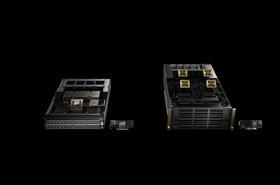The inaugural SmartNICs Summit—held from April 26 to 28, 2022 at the Doubletree Inn in San Jose, California—was well attended by the major Smart NIC vendors. During the Summit, Dell’Oro Group shared the following views of the Smart NICs from the standpoint of market opportunities and use cases.
First, Dell’Oro Group recognizes two types of network interface controllers (or NICs). There are Standard NICs and Smart NICs.
- Standard NICs are also referred to as Foundational NICs, more generically as regular or traditional NICs. Standard NICs provide connectivity between the server and the network, most commonly over Ethernet. Today Standard NICs have port speeds ranging from 1Gbps to 200Gbps. Higher-end Standard NICs that are user-configurable are also referred to as Offload or Performance NICs.
- Regarding Smart NICs, Vendors have come up with other terminologies that are aligned to their target markets or applications, such as DPU, IPUs, DSCs, and so on. Fundamentally, Smart NICs are similar in that they often contain a fully programmable processor such as an ARM, FPGA, or some SoC, with programming language, integrated DRAM and storage, and network fabric and OS. Smart NICs, which can be optimized for a given infrastructure, offload a range of networking, security, and storage services, freeing up the CPU cores to host main applications.
In a presentation on day 1. of the Summit, Dell’Oro Group forecast the Smart NIC market to grow at a CAGR of 26 percent, reaching $1.6 billion in 2026. By comparison, Standard NIC revenue will grow at a CAGR of only 2 percent. We project that Smart NICs will start to cannibalize Standard NICs for workloads and users, starting with the large service providers. By 2026, we estimate that approximately 40 percent of NIC revenue will come from Smart NICs, in contrast with less than 20 percent today. The growth of Smart NICs will not only be accompanied by volume expansion, but by higher product price points. Generally, Smart NICs will command a premium, costing three to five times as much as a Standard NIC of the same port speed.
Prior to the emergence of Smart NICs, the Ethernet adapter market historically was only growing at a rate in the low single digits. We expect Smart NICs to bring new growth opportunity for vendors.
The opportunities
Smart NIC opportunities vary by customer segment:
- The Tier 1 US Cloud is the largest market today but is generally inaccessible to outside vendors.
- The Tier 1 China Cloud and Tier 2 Cloud markets are still accessible to open vendors. Vendors such as Broadcom, Marvell, and Pensando have been successful selling their products in this space.
- Telco is a small slice of the market today but has strong growth potential. Network functions virtualization (NFV) deployed in the mobile networks in the core and edge could leverage Smart NICs.
- The large enterprise segment has very compelling use cases on the horizon, such as acceleration for distributed storage and security.
Several vendor models have emerged. These include major network adapter vendors such as Intel, Marvell, Napatech, and Nvidia, as well as new entrants such as Pensando, Fungible, and Eternity Networks.
Some of the major cloud service providers have deployed servers with their self-built Smart NICs. Microsoft, for example, sourced the Ethernet controller and FPGA from vendors, to build its internally developed Smart NIC. Another example is Google, which developed the Mt. Evans Smart NIC in collaboration with Intel. Other cloud service providers are characterized by a higher level of vertical integration, by which they deploy servers with internally developed Smart NICs containing proprietary silicon. Amazon has been doing this for a number of years, with silicon supplied by its subsidiary, Annapurna Labs. We believe that Alibaba and Huawei are also following this approach, albeit on a smaller scale, as these Chinese vendors seek independence from Western vendors.
As fully programmable devices, Smart NICS can support a wide range of applications. Some use cases were proposed during the SmartNIC Summit by vendors such as AMD, Fungible, Juniper, Intel, Napatech, and Nvidia:
- Networking functions such as load balancing and virtual switches (as common applications).
- Orchestrating network management and security across the data center.
- Providing multi-tenant isolation securely when several users are sharing the same physical server.
- Processing storage and data access protocols NVMe-oF, which enable scalable distributed storage architectures.
- Offloading to the Smart NIC for virtualization tasks such as NFV and the hypervisor used for HCI.
- Packet processing, beneficial for latency sensitive workloads such as AI.
Despite the compelling use cases identified, Vendors need to overcome several major challenges in order to enable greater Smart NIC adoption: 1) high power consumption compared to Standard NICs, 2) lack of open software development solutions, and 3) greater upfront costs (three to five times more than is the case for standard NICs).
As of 2021, roughly a third of the Tier 1 cloud service providers were attached to Smart NICs, led mainly by Amazon and Microsoft. We know that this is mostly a captive market today. We also know that these cloud giants can scale in a way that could overcome these challenges. Some of the Tier 2 cloud service providers are deploying Smart NICs sourced from the open market for select workloads. We estimate that 20 percent of those servers are attached using Smart NICs.
In the rest of the market, mainly the Tier 3 and 4 cloud SPs, Telco, and enterprise, Smart NIC adoption is very small today, at less than one percent of overall server deployments. This has a number of implications, including:
- There is a huge untapped opportunity for Smart NICs.
- Vendors will need to continue to address various challenges with a view toward reducing TCO for customers. And we have seen vendors make progress in this regard. Some are shrinking the process nodes of the dies to lower the power envelope. Some have provided application frameworks and SDKs to enable customers to go to market. Many products today are compatible with standard programming languages such as P4.
As we have seen, vendors make progress in various ways. Some are shrinking the process nodes of the chip, to lower the power envelope. Some have provided application frameworks and SDKs to enable customers to go to market, with standard programming languages such as P4, which the SmartNIC Summit addressed extensively. Vendors are providing solutions based on the open platform, which would free customers from being locked into a particular vendor.
In 2021, excluding the captive market of the Tier 1 cloud service providers, Marvell led all vendors in shipments, followed by Broadcom, Napatech, and Nvidia.
Summary:
- We forecast that the Smar NIC market will grow at a CAGR of 26 percent, to $1.6 B, in 2026.
- Smart NICs are currently deployed primarily by hyperscalers.
- There is a wide range of compelling use cases for smaller cloud service providers and enterprises.
- The open market today is crowded.
- Both capex and opex challenges present themselves.





